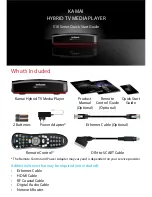
Lantronix
C2110 Install Guide
33415 Rev. C
Page 13 of 24
Product Features
Auto-Negotiation
The Auto-Negotiation feature allows the C2110 to automatically configure itself to achieve the best
possible mode of operation over a link. The C2110 broadcasts its speed (100 Mb/s) and duplex
capabilities (full or half) to the other devices and negotiates the best mode of operation. Auto-Negotiation
allows quick and easy installation because the optimal link is established automatically. No user
intervention is required.
A scenario where the C2110 is linked to a non-negotiating device, disable Auto-Negotiation. In this
instance, the mode of operation will drop to the least common denominator between the two devices
(e.g., 100 Mb/s, half-duplex). Disabling this feature enables forcing the connection to the best mode of
operation.
Half-duplex Network (512-Bit Rule)
In a half-duplex network, the maximum cable lengths are determined by the round trip delay limitations of
each Fast Ethernet collision domain. (A collision domain is the longest path between any two terminal
devices, e.g., a terminal, switch, or router.)
The 512-Bit Rule determines the maximum length of cable permitted by calculating the round-trip delay in
bit-times (BTU) of a particular collision domain. If the result is less than or equal to 512 BTU, the path is
good.
Full-Duplex Network
In a full-duplex network, maximum cable lengths are determined by the type of cables used. See
The 512-Bit Rule does not apply in a full-duplex network.
Pause Control Frame
The pause control feature can improve network performance by allowing one end of the link to signal the
other to discontinue frame transmission for a set period of time to relieve buffer congestion.
Note
: If the pause control feature is present on all network devices attached to the C2110(s), enable the
pause control feature on the C2110(s). Otherwise, disable this feature.










































